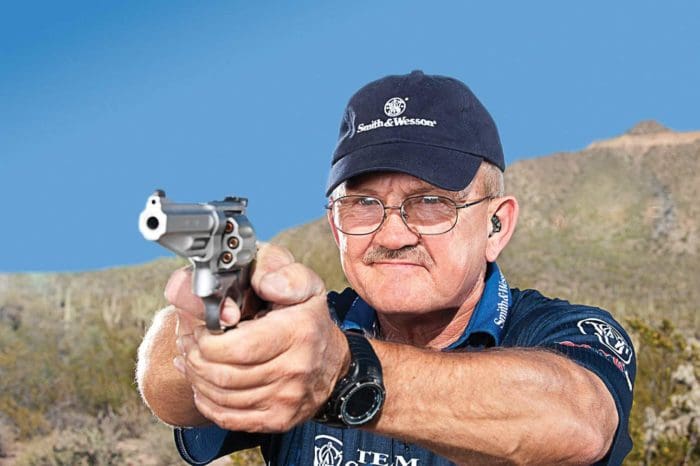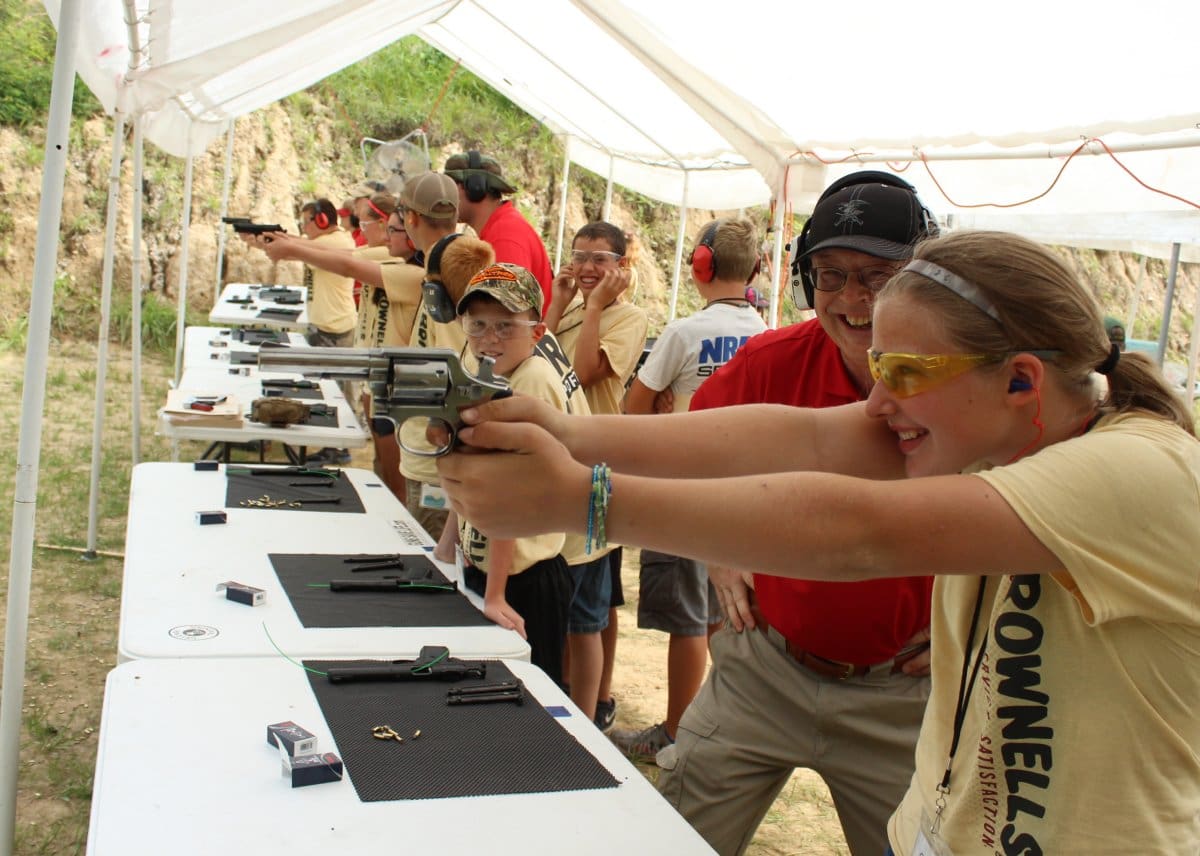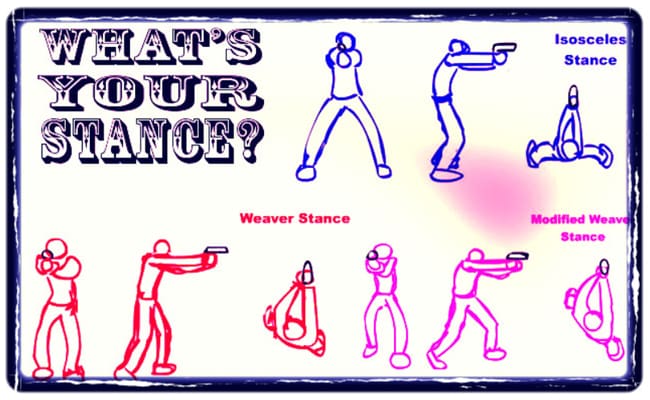By Nancy Thorne of the National Carry Academy
There are a variety of factors that go into shooing a handgun well. The stance, grip, aim, sight alignment, trigger control, follow through and keeping your feet firmly planted are all aspects you’ll need to keep in mind. But let’s focus on the four primary fundamentals of shooting that, with some practice, will make you a better pistol shooter.
1. Stance
A good shooting stance provides a strong, stable platform which is crucial for accuracy. There are two main upright shooting stances – the Isosceles and the Weaver – from which other stances have evolved. While the Weaver is probably better known, the Isosceles is more commonly taught to beginners.
Both the Isosceles and Weaver stances have their proponents, and both have benefits depending on the shooting situation.
The Isosceles stance is the first two-handed stance taught in most basic firearms classes. It’s a naturally defensive stance that is strong, simple and easy to remember under stress. When using this stance, remember some key components:
• Stand facing the target with your feet shoulder width apart.
• Bend your knees slightly.
• Extend the handgun fully toward the target keeping your arms slightly bent.
• With your shoulders squared to the target, your arms form the perfect isosceles triangle from which the stance receives its name.
The Weaver stance is often used by police, military and self-defense advocates because it allows accuracy while presenting a slightly smaller profile. This is the stance you usually see in movies and TV shows.
• Stand with your feet shoulder width apart with your strong-side leg slightly back in what is often called a boxer’s stance.
• Angle your support arm’s shoulder toward the target.
• Bend your knees while keeping your body weight slightly forward.
• Grasp the gun using opposite pressure with both hands.
• Keep both elbows bent with the support elbow pointing downward.
2. Grip
The two-handed grip is one of the most popular, commonly used methods for holding a pistol. Hold the pistol with the weak hand while making a Y out of the thumb and fingers of the strong hand.
Then place the back strap of the gun against the middle of the intersection of the thumb and forefinger, allowing your fingers to wrap around the grip.
Next, bring the support hand around the front of the strong hand grip overlapping the fingers of the strong hand grip, aligning the knuckles of both hands on each side of the grip.
When done correctly, the grip will provide plenty of firm holding power for aiming and firing the gun, while allowing it to remain relatively stable and in the same position after recoil.
Note that the thumbs on a semi-automatic pistol are positioned with the weak thumb positioned slightly in from or the strong hand thumb, and below the gun’s slide to protect them from impeding the sliding action during discharge. For the revolver, the weak hand thumb rests over top of the strong hand thumb for added stability and to stay clear of the cylinder.

Grip consistency is important for accuracy. Because grips are slightly different between makes and models, some will be smaller or larger than others, so you may need to make slight adjustments depending on the model gun you’re using. It’s always recommended to practice with the pistol you will use most often, such as a carry pistol to ensure consistent positioning.
3. Sight Alignment
Sight alignment is the relationship between the shooter’s eye, the rear sight aperture, and the front sight. You need to center the front sight blade with the rear sight aperture.
When aiming, the front sight is positioned in the middle of the rear sight notch with an equal space on each side. The horizontal top surface of the front sight is on the same level as the top horizontal surface of the rear sight notch. It is necessary to be acutely aware of the relationship of the rear sight to the clearly defined front sight.
Normal vision is such that most people can’t get both the rear and front sights in focus. In general, it’s best to focus on the front sight. Your rounds will generally end up where you’ve placed the front sight if your other variables (stance, grip, trigger pull) are taken care of.
4. Trigger Control
Trigger control is the skillful manipulation of the pistol’s trigger so you’re able to hit what you’re shooting at. You’ll need to work on depressing the trigger while maintaining good sight alignment and sight picture. That can be easier said that done, but remember these tips:
● You need even, consistent pressure applied to move the trigger straight to the rear of the pistol, which isolates the movement of the trigger finger.
● Use a firm grip to maintain sight alignment and sight picture – don’t stop, hesitate or pause. The trigger pull should be one smooth press. Don’t anticipate the gun firing; let the sound of the bang surprise you.
● When the shot is fired, regain your sight alignment and sight picture as quickly as you can to prepare for the next shot in precisely the same way.
The trigger press and the placement of the trigger finger are both crucial. For the semi-auto, the middle of your fingerprint on the index finger is about where your finger placement should rest on the trigger.
When you’re shooting, if your shots are consistently landing to one side of the bulls eye or the other, check where your finger is resting on the trigger. Too much trigger finger on the trigger can pull shots toward your strong side. Too little finger on the trigger can cause shots to be pushed to your weak side.
There are other variables, but if you master these four fundamentals, you’ll be a long way toward the goal of being an accurate, effective pistol shooter. It only takes three things to get you there: practice, practice and more practice.
National Carry Academy is the nation’s premiere firearm training resource for those who decide to carry a gun as part of their lifestyle. NCA offers online and in-person courses in over thirty states, and provides our students with the resources necessary to obtain their conceal and carry.









On Yesterday. Saturday, I completed my volunteer training to become a 4-H shooting instructor. I can’t change the entire world. But I can work on my little piece of it. Here in western KY. There are evil people out there, who are working to stop children from learning, about their god given American birth rights.
“Ammiano was instrumental in getting rid of San Francisco’s High School competitive .22 cal rifle teams, and worked to put an end to the junior ROTC program in San Francisco’s High Schools. Ammiano supported the ban on allowing gun owners to carry an unloaded gun in public. “Whether a gun is loaded or not, it’s still an act of intimidation and bullying,” Ammiano said.
https://calwatchdog.com/2013/01/29/anti-gun-lawmakers-lead-hearing-today/
All outstanding advice for shooting…at the range.
Pretty effing useless when you’re trying to stop the bad guy in a dark alley.
Yep…have a gun and be prepared to use it. Like that old lady with a loaded 38 in her nightstand .
Beat me to it. 🙂 Or in your bedroom at 2am.
Agreed.
I use number three finger pad position for everything but a riffle
Well not everyone starts out laying out $500 for weekend of tactical operator self defense training. You have to be able to hit paper first.
“For the revolver, the weak hand thumb rests over top of the strong hand thumb for added stability and to stay clear of the cylinder.”
*shows picture of best shooter in the world holding the revolver different way.* lol
Dig those feet in, and watch this:
https://www.youtube.com/watch?v=v6fv2GBx8Sg
I hang tattoo’ed skins on my wall, kinda like a trophy. I wish they’d quit getting snakes tattooed on their penises though.
That video is nothing but DHS cowboy wannabe bullshit. Nobody in his or her right mind would go out attired like that. It would attract cops like yellow jackets to sugar and rightly so. There are damn good reasons for concealed carry.
Hey, I’ve seen that little girl in the cover photo, I’ve seen that grin when she discovered she actually hit something with a real gun! Only other place I’ve seen that smile is the first time she parks a motorcycle safely, after driving around the block alone. At that age, they ain’t so hard to please.
Sight alignment, sight picture, and trigger control are the only 3 fundamentals of shooting. Anything else is a technique.
I appreciate this article because its content is very quality, I will definitely share it with friends and relatives, hope you always stay healthy to make more articles.
Your article is very good, I really like it and I will definitely share it with my friends, hope you always stay healthy. thanks a lot.
This is really a great article I really like and will definitely share it widely with my friends, wish you always good health and make more articles in the future. thank you
I appreciate your article very well, the content as well as the attached images you share with me, I will definitely share it with my friends, wish you always good health and write more blogs. Please
This is really a very good article that I really like and will definitely share it widely with my friends, wish you all good health and make more articles in the future. thank
My husband and I are looking for new hobbies this summer. I think we might try pistol shooting to help improve our focus. So, thanks for these basic tips such as doing the proper trigger pull so as not to aim the shot on the stronger side.
The article has extremely high-quality content, I appreciate it, your article will certainly bring a lot of useful knowledge to everyone. respect you
That stuff is all well and good for shooting targets that aren’t trying to hurt you, and it should be included in regular practice to keep fundamentals ingrained, but in an actual defensive use it pretty much goes out the window. For that you’re better served training one handed, weak handed, point shooting, awkward positions, poor lighting, half asleep, startled, surprised, tired, scared, nervous, moving, targets moving, along with a lot of simulated innocents mixed in, etc., getting very quick hits on only those that need shooting and recognizing when and who not to shoot.
Perfect stances and grips and highly accurate target shooting is good stuff but it’s only one part out of a lot of parts.
When people ask about pistols or calibers for defense, instead of going into a speech about all the options out there I just tell them to go to a range that rents and try out everything you can. Start by just holding them and select a few that feel like a good fit in either hand. Then pick the most powerful one you can still (after a little familiarization and practice) keep all your shots on a torso shooting one-handed out to at least 10 yards. Farther is better but 30 feet is “across the room distance” even in fairly large houses. Consider yourself lucky if you can recognize what’s happening, react to it, and get a shot off while they’re still that far away.
Comments are closed.